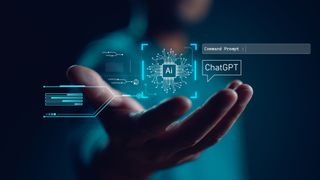The film industry is renowned for vividly depicting an imagined near future. Think humanoid robots (I, Robot), memory erasure (Eternal Sunshine of the Spotless Mind) or even life extension (Vanilla Sky). Inevitably, some portrayals and predictions are wide of the mark; others, however, give viewers a glimpse of what technology is to come.
While we still haven’t unlocked the full potential of fully automated cars or jetpack transportation, Steven Spielberg’s adaptation of the novel, Minority Report, managed to correctly anticipate some aspects of the future – such as personalized digital ads, iris recognition software and kinetic virtual interfaces. Subtly, though, the film’s most central theme has become its most prescient: technology capable of predetermination.
Set in 2054, the sci-fi whodunnit imagines a world in which a trio of ‘precognitive’ humans can foresee violent crimes before they’re committed. Tom Cruise stars as a detective accused of ‘future-murder’, with the narrative following his attempts to acquire the titular ‘report’, alleged to contain information integral to the incriminating prophecy.
In reality, it’s fair to say we tend not to rely on clairvoyants as credible sources for identifying impending issues. However, the film’s ‘pre-crime’ measures do share similarities with the ways we now use AI tools to protect our digital ecosystems – coincidentally bringing Gartner’s premonition to life that ‘there is no future of IT operations that doesn’t include artificial intelligence for IT operations (AIOps)’.
Perhaps the modern-day relevance of the 22-year-old Minority Report is why a stage adaptation was launched in the UK this year…
Director of Solutions Engineering, UK & Ireland, at Riverbed Technology.
Back to reality
Today, IT managers have a big task on their hands. They’re responsible for keeping their business operational and secure – while striving to constantly improve the digital experiences (DEX) they provide.
Alongside their teams, IT leaders are expected to deal with the flood of notifications and alerts that occur as a byproduct of managing huge numbers of applications within unnecessarily complex digital estates. On top of this, they’re also tasked with triaging and remedying a varying severity of incoming help desk tickets.
According to market research, over a third of managers (38%) feel overwhelmed by this mounting burden of information – showing it’s not unusual for IT infrastructure to become so overloaded with data that it begins to obstruct operational efficiency and clarity.
This presents a challenge that requires IT teams to seamlessly juggle their time and people – but unfortunately, the majority of businesses don’t have a full armory of Hollywood technology at their disposal. The best way to address these problems is to get ahead of them.
“Now, the system can work for you”
What today’s businesses need, then, is software capable of identifying and resolving issues before they escalate into notifications, alerts or tickets. Or, to use a term from Minority Report: ‘precognitive’ technology.
AIOps can be that solution. Platforms are available on the market today that proactively manage IT operations on behalf of IT managers and their teams – taking the burdens of resource and cost away from human labor, and towards digital autonomy. This empowers the IT estate to run more self-sufficiently, allowing IT leaders to refocus on bigger issues, like delivering superior DEX or maximizing commercial opportunities.
The added flexibility and freedom this permits IT managers is surely why 45% of those polled in Riverbed’s Global DEX Survey identified AI as being increasingly business-critical – the most of any new or familiar technology expected to reshape digital experiences in the next eighteen months.
“We see what they see”
Imagine a scenario in which a well-respected retailer experiences higher volumes of digital traffic during peak times. If their website lacks the agility to cope with this increased demand, they risk encountering issues like downtime or transaction failures. Similarly, the applications, devices and networks they rely on to deliver exceptional service in-store or in the customer contact centre might also falter, with employees contacting support teams in their droves. Altogether, insufficient and outdated IT could affect their sales, reputation and customer satisfaction.
This hypothetical organization could avoid these issues by embracing AIOps, which uses AI and machine learning to conduct an ongoing appraisal of performance metrics and network patterns – IT’s very own ‘minority report’ if you will. By analyzing the historical evidence they collect, these platforms can then identify anomalies and predict forthcoming issues, such as overwhelmed servers, disk space shortages or application incompetency's.
These ‘pre-visions’ – to borrow more jargon from the film – offer the kind of data-driven insights that support the strategic interests of IT teams. Decision-makers can rely on this added end-to-end visibility to develop a comprehensive image of their organization's digital vulnerabilities, before then targeting the relevant changes. To make things even simpler, many intelligent automation platforms can even implement these fixes without the need for human intervention.
A new age
By proactively surfacing fledgling issues and automatically remediating them before they develop into active problems, AIOps relieve IT teams of the responsibility of finding and fixing these concerns themselves. Harnessing these added capabilities empowers businesses to increase their uptime and deliver accelerated network performance – providing their customers with exceptional digital experiences.
Eliminating emergency error resolutions and avoiding digital downtime also considerably reduces IT team workload. In this way, the extra security and efficiency granted by AIOps enable organizations to unlock substantial cost savings.
While the progress we’ve made in the tech industry might not have realized Steven Spielberg’s full cinematic vision quite yet, the emergence of sophisticated AIOps has ushered in IT’s very own Minority Report era.
Not only are businesses experiencing enhanced network reliability, but their newfound time, money and resources can now be reallocated towards embracing the next phase of digital innovation – whatever that might be.
We list the best workstations.
This article was produced as part of TechRadarPro's Expert Insights channel where we feature the best and brightest minds in the technology industry today. The views expressed here are those of the author and are not necessarily those of TechRadarPro or Future plc. If you are interested in contributing find out more here: https://www.techradar.com/news/submit-your-story-to-techradar-pro







:quality(85):upscale()/2024/11/04/810/n/1922564/da875c20672911f51e8a59.58915976_.jpg)


 English (US) ·
English (US) ·